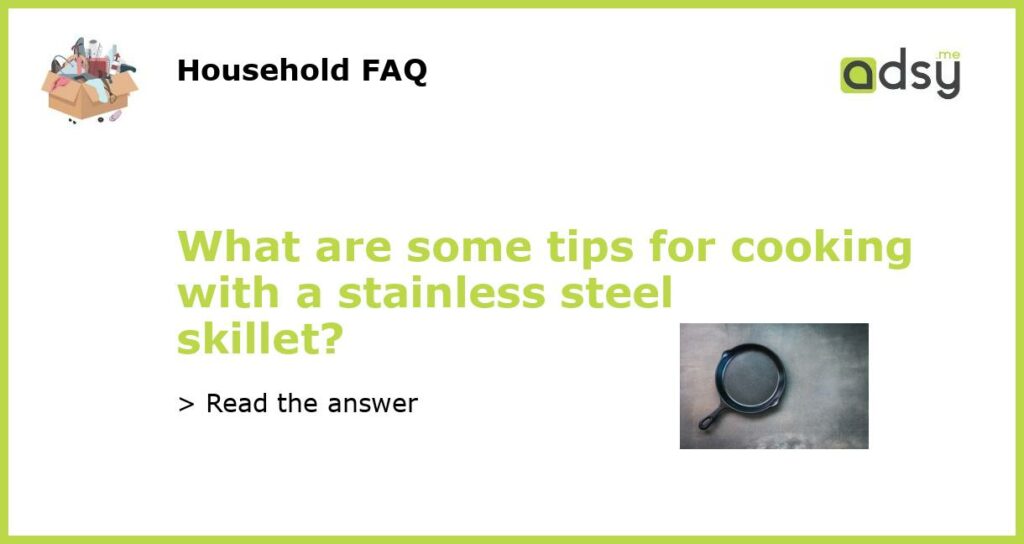Understanding the Benefits and Challenges of Cooking with a Stainless Steel Skillet
Cooking with a stainless steel skillet can be a rewarding experience for home cooks and professional chefs alike. Stainless steel skillets offer excellent heat distribution, durability, and versatility in the kitchen. However, they also present some challenges when it comes to cooking certain ingredients. Here are some tips to help you make the most of your stainless steel skillet:
Preheating and Seasoning Your Stainless Steel Skillet
One of the most important steps in cooking with a stainless steel skillet is preheating it before adding any ingredients. This helps the skillet to distribute heat evenly and prevents food from sticking to the surface. To preheat your skillet, place it on the stove over medium heat for a few minutes. You can test if it’s ready by adding a few drops of water to the skillet. If the water sizzles and evaporates quickly, the skillet is preheated and ready to use.
Another tip to prevent food from sticking to the surface of your stainless steel skillet is to season it. Seasoning a stainless steel skillet involves coating the surface with a thin layer of oil and heating it to create a natural non-stick surface. To season your skillet, heat it over medium-high heat, add a small amount of oil, and spread it evenly across the surface with a paper towel. Allow the oil to heat until it starts to smoke, then remove the skillet from heat and wipe away any excess oil with a paper towel. Your skillet is now seasoned and ready to use.
Choosing the Right Oil for Cooking
When cooking with a stainless steel skillet, it’s important to choose the right oil for the job. Oils with a high smoke point, such as canola, grapeseed, or avocado oil, are ideal for high-heat cooking methods like frying and searing. These oils can withstand high temperatures without breaking down or smoking. Avoid using oils with low smoke points, such as olive oil or butter, as they can burn and leave a residue on the surface of your skillet.
Using the Proper Cooking Techniques
While stainless steel skillets are versatile and can be used for a variety of cooking techniques, there are a few tips to keep in mind to achieve the best results. When searing meat, for example, it’s important to let it develop a golden crust before flipping it. This helps to seal in the juices and prevent sticking. Avoid overcrowding the skillet, as this can lower the temperature and result in uneven cooking.
Another important technique to remember when cooking with a stainless steel skillet is to use a metal spatula or tongs instead of a fork. Metal utensils are less likely to scratch the surface of the skillet and can help you achieve a better sear on meats. Lastly, be patient and resist the temptation to constantly stir or flip your food. Allowing it to cook undisturbed for a few minutes helps to develop a flavorful crust and promote even cooking.
Cleaning and Maintaining Your Stainless Steel Skillet
To keep your stainless steel skillet in optimal condition, it’s important to clean and maintain it properly. After each use, allow the skillet to cool completely before washing it with warm, soapy water. Avoid using abrasive cleaners or scrubbing pads, as they can scratch the surface. Instead, use a sponge or soft cloth to gently remove any food residue.
If your skillet develops stubborn stains or discoloration, you can try soaking it in a mixture of vinegar and water or using a stainless steel cleaner. Regularly seasoning your skillet, as mentioned earlier, can also help to maintain its non-stick surface and prevent food from sticking.
Cooking with a stainless steel skillet can be a rewarding experience, as it offers excellent heat distribution and durability. By preheating and seasoning your skillet, choosing the right oil, using the proper cooking techniques, and cleaning and maintaining it properly, you can unlock the full potential of your stainless steel skillet and create delicious meals in the process.





